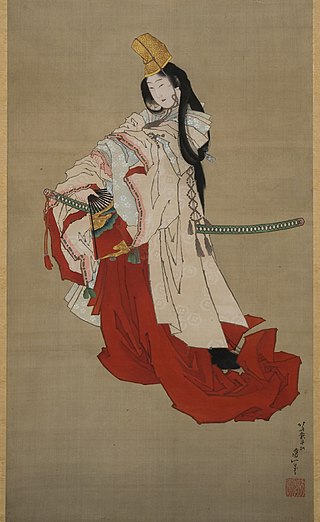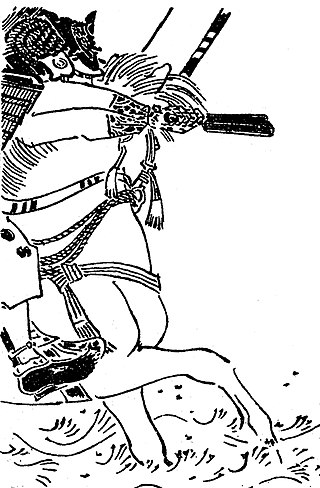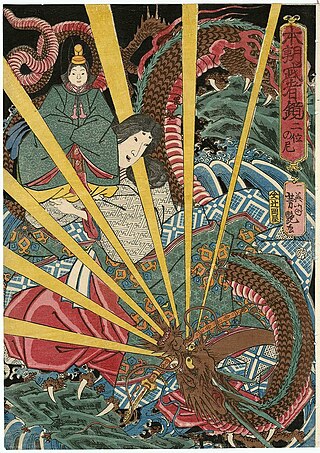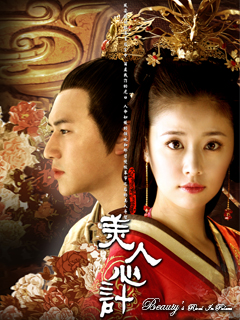
The Tale of Genji, also known as Genji Monogatari is a classic work of Japanese literature written by the noblewoman, poet, and lady-in-waiting Murasaki Shikibu around the peak of the Heian period, in the early 11th century. The original manuscript no longer exists. It was made in "concertina" or orihon style: several sheets of paper pasted together and folded alternately in one direction then the other.

Hikaru Genji (光源氏) is the protagonist of Murasaki Shikibu's important Heian-era Japanese novel The Tale of Genji. The story describes him as a superbly handsome man and a genius. Genji is the second son of a Japanese emperor, but he is relegated to civilian life for political reasons and lives as an imperial officer.

The Tale of Genji: Dreams at Dawn is a Japanese manga series written and illustrated by Waki Yamato. It is a manga version of Murasaki Shikibu's The Tale of Genji, following nearly the same plot with some modern adaptation. It was serialized in Kodansha's shōjo manga magazines Mimi and Minmi Excellent from 1979 to 1993, with its chapters collected in 13 tankōbon volumes. The first ten volumes focus on Hikaru Genji and his life, while the final three volumes follow two princes, lord Kaoru and Niou no Miya after Hikaru Genji's death.

Minamoto (源) was a noble surname bestowed by the Emperors of Japan upon members of the imperial family who were excluded from the line of succession and demoted into the ranks of the nobility since 814. Several noble lines were bestowed the surname, the most notable of which was the Seiwa Genji, whose descendants established the Kamakura and Ashikaga shogunates following the Heian era. The Minamoto was one of the four great clans that dominated Japanese politics during the Heian period in Japanese history—the other three were the Fujiwara, the Taira, and the Tachibana.

The Taira (平) was one of the four most important clans that dominated Japanese politics during the Heian period of Japanese history – the others being the Minamoto, the Fujiwara, and the Tachibana. The clan is divided into four major groups, named after the emperors they descended from: Kanmu Heishi, Ninmyō Heishi, Montoku Heishi, and Kōkō Heishi, the most influential of which was the Kanmu Heishi line.

The Genpei War was a national civil war between the Taira and Minamoto clans during the late Heian period of Japan. It resulted in the downfall of the Taira and the establishment of the Kamakura shogunate under Minamoto no Yoritomo, who appointed himself as Shōgun in 1192, governing Japan as a military dictator from the eastern city of Kamakura.

The Tale of the Heike is an epic account compiled prior to 1330 of the struggle between the Taira clan and Minamoto clan for control of Japan at the end of the 12th century in the Genpei War (1180–1185).

The Tale of the Bamboo Cutter is a monogatari containing elements of Japanese folklore. Written by an unknown author in the late 9th or early 10th century during the Heian period, it is considered the oldest surviving work in the monogatari form.

Suetsumuhana (末摘花) is the archaic Japanese word for the safflower. It is known now as Benibana (紅花).

Minamoto no Mitsunaka was a Japanese samurai and court official of the Heian period. He served as Chinjufu-shōgun and acting governor of Settsu Province. His association with the Fujiwara clan made him one of the wealthiest and most powerful courtiers of his day.

Lady Fujitsubo (藤壺) is a fictional character in Murasaki Shikibu's The Tale of Genji.

Shizuka Gozen (静御前) (1165–1211), or Lady Shizuka, one of the most famous women in Japanese history and literature, was a shirabyōshi of the 12th century, and a mistress of Minamoto no Yoshitsune. Since she, like many others, are featured largely in the Heike Monogatari, Gikeiki, and a number of plays of various traditions, her story is quite well known, but it is difficult to separate fact from fiction within it.

Ashikaga Yoshikane was a Japanese samurai military commander, feudal lord in the late Heian and early Kamakura period of Japan's history. He played an active part in the Jishō-Juei War and the later military campaign as a closely related person of the first Kamakura shōgun Minamoto no Yoritomo, and made Ashikaga clan influential position in gokenin vassal of the Kamakura shogunate.

Crows Zero, also known as Crows: Episode 0 is a 2007 Japanese action film directed by Takashi Miike with a screenplay by Shōgo Mutō. It is based on the manga Crows by Hiroshi Takahashi and stars Shun Oguri, Kyōsuke Yabe, Meisa Kuroki and Takayuki Yamada. The plot serves as a prequel to the manga and focuses on the power struggle between gang of students at Suzuran All-Boys High School.

Taira no Tokiko was a Japanese aristocrat from the Heian period. She was the concubine of Taira no Kiyomori, mother of Taira no Tokuko, and grandmother of Emperor Antoku. Later she took the vows to become a nun, after which she was generally referred to by her Buddhist name as the "Nun of the Second Rank".

Beauty's Rival in Palace is a 2010 Chinese television series adapted from Xiao Qiying's short story Turbulence in the Empress' Chamber (未央沉浮). It was first broadcast on Shanghai TV Drama on 15 March 2010. The series was one of the highest-rated Chinese TV series in 2010.
Yoshitsune (義経) is a Japanese television drama series originally broadcast between 9 January and 11 December 2005, with a three-part special compilation being aired from 24 December to 25 December 2005. The 44th Taiga Drama, the original work is by Miyao Tomiko, screenplay by Kaneko Narito and starring Hideaki Takizawa.
Fujiwara no Teishi, also known as Sadako, was an empress consort of the Japanese Emperor Ichijō. She appears in the literary classic The Pillow Book written by her court lady Sei Shōnagon.

The Heike Story is a Japanese original net animation series adapted from Hideo Furukawa's 2016 translation into modern Japanese of The Tale of the Heike, a 13th-century historical epic depicting the rise and fall of the Taira clan. The series was produced by Science SARU and directed by Naoko Yamada, and streamed from September 16 to November 25, 2021 on Fuji TV's on Demand (FOD)'s service, as well as on Funimation. This was then followed by the television broadcast through the same network's +Ultra programming block, which aired from January 13 to March 17, 2022.

















